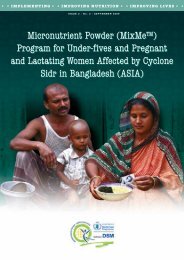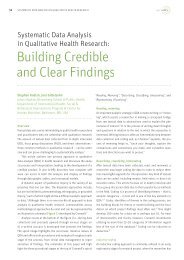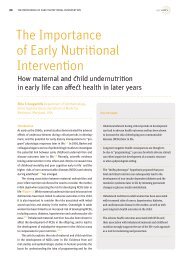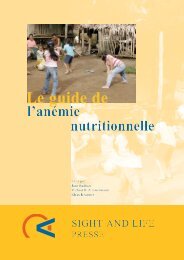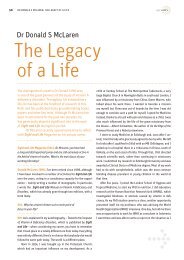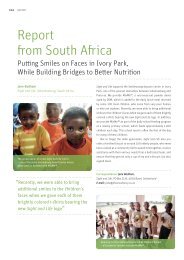16 intrauterine programming of ncd 24 olson memori... - DSM
16 intrauterine programming of ncd 24 olson memori... - DSM
16 intrauterine programming of ncd 24 olson memori... - DSM
- No tags were found...
You also want an ePaper? Increase the reach of your titles
YUMPU automatically turns print PDFs into web optimized ePapers that Google loves.
SIGHT AND LIFE | VOL. 25 (2) | 2011 INTRAUTERINE PROGRAMMING OF NCD 2121pected to reveal the long-term effects <strong>of</strong> maternal nutrition onadipocyte functioning in <strong>of</strong>fspring.Follow-up <strong>of</strong> the PMNS childrenThe Developmental Origins <strong>of</strong> Health and Disease (DOHaD) theorysuggests that structural and functional changes in the fetusconsequent upon maternal nutritional, metabolic and other influencespersist in later life. There are not many human studieslinking maternal nutrients with <strong>of</strong>fspring body composition andrisk factors for NCD. Design <strong>of</strong> the PMNS allows us to follow upthe children and study the effects <strong>of</strong> fetal <strong>programming</strong>.We found that a child’s adiposity (DXA) and insulin resistance,the two major risk factors for future diabetes, were significantlyrelated to maternal micronutrient nutrition, especially those nutrientswhich regulate 1-C metabolism. Maternal folate concentrationswere directly related to the adiposity <strong>of</strong> the child at sixyears <strong>of</strong> age, and also to insulin resistance. On the other hand,low maternal vitamin B₁₂ status predicted higher insulin resistance.The most insulin resistant children were born to motherswho had the lowest vitamin B₁₂ but highest folate status. 30In addition, we found that maternal vitamin B₁₂ and folatepredicted a child’s neurocognitive function, suggesting that the1-C metabolism <strong>of</strong> the mother also programs the child’s braindevelopment and function. 31“Our research suggests that animbalance in vitamin B₁₂ and folatenutrition and consequent disturbancesin maternal 1-C metabolismmay contribute to the epidemic <strong>of</strong>adiposity and T2D in India”influences the growth <strong>of</strong> a fetus and its future health and susceptibilityto disease. This will be a step forward in the “primordialprevention” <strong>of</strong> diabetes and other NCDs.“Future research should target theoption <strong>of</strong> intervening in the youngto influence the intergenerationaltransmission <strong>of</strong> health”SummaryRecent developments in the field <strong>of</strong> DOHaD have thrown an interestinglight on the life-course evolution <strong>of</strong> many <strong>of</strong> the chronicNCDs. It is becoming increasingly obvious that a substantial proportion<strong>of</strong> adult health is programmed in utero. The health <strong>of</strong>young girls in a community is <strong>of</strong> paramount importance and is amajor influence on the health <strong>of</strong> the next generation. Maternalmicronutrient nutrition contributes to the fetal <strong>programming</strong><strong>of</strong> NCDs. Current ideas on preventing NCDs in the middle-agedand the elderly via difficult-to-perform lifestyle adjustments arevery ineffective models. Future research should target the morepromising option <strong>of</strong> intervening in the young to influence theintergenerational transmission <strong>of</strong> health. Balanced micronutrientnutrition <strong>of</strong> young mothers may be the key.AcknowledgementsWe are funded by the Wellcome Trust (London, UK); the NestléFoundation (Lausanne, Switzerland); The International AtomicEnergy Agency (Vienna, Austria); the Department <strong>of</strong> Biotechnology(DBT), Government <strong>of</strong> India (New Delhi, India); and Sightand Life, Basel, Switzerland. Thanks are due to colleagues, collaborators,field workers, and parents and children who participatedin the studies mentioned in this article.In the PMNS, two-thirds <strong>of</strong> mothers had low vitamin B₁₂ (10 μmol/L). Folate deficiency was rare. 29 Thisnutrient pattern is at least partly ascribable to vegetarian foodhabits and partly to the prescription <strong>of</strong> folic acid by obstetricians.Our research suggests that an imbalance in vitamin B₁₂and folate nutrition and consequent disturbances in maternal1-C metabolism may contribute to the epidemic <strong>of</strong> adiposity andT2D in India.Folate and vitamin B₁₂ are the major methyl donors in diet,and methylation <strong>of</strong> DNA is one <strong>of</strong> the major mechanisms <strong>of</strong> regulation<strong>of</strong> gene expression (epigenetics). Methylation silences thegenes and affects the phenotype. It will be important to studyhow an improvement in the maternal nutrition <strong>of</strong> these nutrientsCorrespondence: Pr<strong>of</strong>. Chittaranjan S Yajnik, Diabetes Unit,6th floor, Banoo Coyaji Building, KEM Hospital, Rasta Peth, Pune411011, Maharashtra, India E-mail: diabetes@vsnl.com⇢



